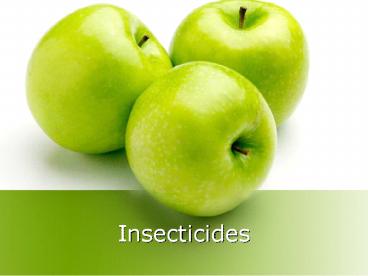Insecticides PowerPoint PPT Presentation
1 / 44
Title: Insecticides
1
Insecticides
2
PESTICIDE CHARACTERISTICS
- Age
- Best used when mixed, dont store after mixing
3
PESTICIDE CHARACTERISTICS
- Thatch
- Excessive thatch (gt1/2) binds insecticide
4
PESTICIDE CHARACTERISTICS
- UV degradation
- Breaks chemical bonds
- Biologicals most susceptible
5
PESTICIDE CHARACTERISTICS
- pH impact
- Neutral pH is best
6
PESTICIDE CHARACTERISTICS
- Microbial degradation
- Bacteria and fungi feed on organic portion of
pesticide - Can break down within hours
7
GENERAL CLASSIFICATION
- Stomach poisons
- Enter insect through the gut when eaten
8
GENERAL CLASSIFICATION
- Systemic poisons
- Translocated within plants
- Insects exposed when feeding
- Most effective on piercing-sucking insects
- Receive greater dose
9
GENERAL CLASSIFICATION
- Contact poisons
- Enter body when insect walks over treated surface
10
GENERAL CLASSIFICATION
- Insect Growth Regulator (IGR)
- Interferes with normal growth
- Prevents molting (juvenile hormones)
- Very safe, delayed effect
11
GENERAL CLASSIFICATION
- Biorational (Biological)
- Beneficial fungi, nematodes or bacteria
12
MODE OF ACTION
- Nerve poisons most conventional insecticides
- a) Narcotics
- Physical action in nervous system
13
MODE OF ACTION
- Nerve poisons
- b) Synaptic
- Interrupt synaptic transmission of nervous system
- Synapse (gap) is the junction between a neuron
and another cell (muscle, gland, etc)
14
MODE OF ACTION
- Nerve poisons
- b) Synaptic
- In central nervous system, acetylcholine
transmits an impulse across synapse to next cell - Chemicals tie up acetylcholine and cause
malfunction
15
MODE OF ACTION
- Muscle poisons
- Disrupting muscle membrane
16
MODE OF ACTION
- Physical toxicants
- Horticultural Oil
- Clog the spiracles that breathe
17
MODE OF ACTION
- Physical toxicants
- Insecticidal soap
- Strips cuticle and dehydrates insect
18
MODE OF ACTION
- Physical toxicants
- Diatomaceous earth
- Crushed fossils
- Cut insects walking over it
- Dehydrate
19
SOURCE CLASSIFICATION
- Inorganic lack carbon
- Organic possess carbon
- Natural are produced from natural substances
botanicals and oils - Synthetics are manmade
20
MAJOR CLASSES OF ACTIVE INGREDIENTS
- Pesticide rotation
- Rotate chemical classes
- Change mode of action (MOA)
- http//www.irac-online.org/
21
MAJOR CLASSES OF ACTIVE INGREDIENTS
- ORGANOPHOSPHATES (OP)
- Unstable in light
- Was most widely used insecticides
22
MAJOR CLASSES OF ACTIVE INGREDIENTS
- ORGANOPHOSPHATES (OP)
- Malathion,
- Diazinon and Chlorpyrifos (Dursban)
- Cancelled
23
MAJOR CLASSES OF ACTIVE INGREDIENTS
- CARBAMATES
- Low persistence in environment
- Noted toxicity to pollinators
24
MAJOR CLASSES OF ACTIVE INGREDIENTS
- CARBAMATES
- Carbaryl
- Greatest use is fruit production
- Controls insects and fruit-thinning agent
25
MAJOR CLASSES OF ACTIVE INGREDIENTS
- CARBAMATES
- Carbofuran (cancelled)
- Ineffective when used continuously
- Microorganisms quickly degrade
26
MAJOR CLASSES OF ACTIVE INGREDIENTS
- CHLORINATED HYDROCARBONS
- Most persistent insecticide class
27
MAJOR CLASSES OF ACTIVE INGREDIENTS
- CHLORINATED HYDROCARBONS
- DDT Cancelled in US in 1973
- Extremely stable
- Resistant to MO, heat, and UV light
- Fat solubility
- Other classes broken down in animals by enzymes
28
MAJOR CLASSES OF ACTIVE INGREDIENTS
- CHLORINATED HYDROCARBONS
- DDT 2 characteristics for cancellation
- 1. Stability allows more to be taken up by
animals - 2. Accumulates in body fat
- Found traces in milk fat and in human body fat
29
MAJOR CLASSES OF ACTIVE INGREDIENTS
- CHLORINATED HYDROCARBONS
- DDT
- Biomagnification
- As predators consume organisms, DDT accumulates
in fat of predator - Thin egg shells, reproductive failure
30
MAJOR CLASSES OF ACTIVE INGREDIENTS
- BOTANICALS
- Derived directly from plants
- Organic gardening
- Considered safer, some exceptions
- Most are expensive and impractical on commercial
scale
31
MAJOR CLASSES OF ACTIVE INGREDIENTS
- BOTANICALS
- Pyrethrum
- Extracted from Chrysanthemum
- Wide spectrum and rapid knockdown
- Breaks down rapidly in sunlight
32
MAJOR CLASSES OF ACTIVE INGREDIENTS
- BOTANICALS
- Rotenone
- Second most used botanical
- Extremely toxic to fish
33
MAJOR CLASSES OF ACTIVE INGREDIENTS
- BOTANICALS
- Rotenone
- New research released in the United States on
Monday shows a link between the use of two
pesticides, rotenone and paraquat, and
Parkinson's disease. People who used either
pesticide developed Parkinson's disease
approximately 2.5 times more often than
non-users.
34
MAJOR CLASSES OF ACTIVE INGREDIENTS
- BOTANICALS
- Neem
- Oil from neem tree
- Primarily repellent
- Also medicinal and toothpaste
- http//www.azasol.com/
35
MAJOR CLASSES OF ACTIVE INGREDIENTS
- PYRETHROIDS (SYNTHETIC)
- Replacing many older insecticides effective and
safe - Synthetic pyrethrum
36
MAJOR CLASSES OF ACTIVE INGREDIENTS
- PYRETHROIDS (SYNTHETIC)
- Permethrin
- High toxicity at low rates
- Quick knockdown
- More stable
- Permethrin, Cyfluthrin, Deltamethrin
37
MAJOR CLASSES OF ACTIVE INGREDIENTS
- PHENYL PYRAZOLES
- Low mammalian toxicity
- Very effective
- Fipronil, season long control of ants
38
MAJOR CLASSES OF ACTIVE INGREDIENTS
- CHLORONICOTINYLS
- Translocates within plant
- Merit is absorbed through roots
- Suspected in CCD (bees)
- Banned in Canada
39
Colony Collapse Disorder (CCD)
- Adult bees fly off to die
- Causes include parasites, viruses, bacteria, poor
nutrition and pesticides - No proof of cell tower
40
MAJOR CLASSES OF ACTIVE INGREDIENTS
- BIORATIONAL (Biological)
- Not substitute for conventional insecticides
- More scouting and repeat applications
41
MAJOR CLASSES OF ACTIVE INGREDIENTS
- BIORATIONAL (Biological)
- Bt (Bacillus thurigiensis)
- Protein produced by Bt that damages gut
- Death in couple days
42
MAJOR CLASSES OF ACTIVE INGREDIENTS
- BIORATIONAL (Biological)
- Bt (Bacillus thurigiensis)
- Varieties have specific host
- Var. kurstaki kills caterpillars (Dipel)
- Genetically modified corn contains protein
- Monarch butterflies?
43
MAJOR CLASSES OF ACTIVE INGREDIENTS
- BIORATIONAL (Biological)
- Bt (Bacillus thurigiensis)
- Var. israliensis kills mosquitoes
44
MAJOR CLASSES OF ACTIVE INGREDIENTS
- BIORATIONAL (Biological)
- Spinosad
- Derived from bacterium
- Effective flea control

